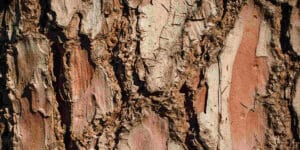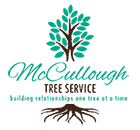By: Shelby McCullough| Published: April 3, 2023
Not sure if your tree has a disease or not? Call McCullough Tree Service at (407) 734-5854.

You likely take excellent care of your trees, so it can be alarming when you spot one that’s shedding bark. It’s normal for certain trees to shed bark naturally, but in some cases, your tree may be suffering from what’s known as peeling tree bark disease. Learn what to look for in this guide from the tree service experts in Orlando, FL.
What Is Peeling Tree Bark Disease?
Peeling tree bark disease usually affects hardwood trees such as oak, hickory, maple, birch, and beech. This disease, also called hypoxylon canker, develops when a fungus takes hold of your tree. In addition to peeling bark, the disease causes:
- Dying branches
- Leaves that wilt and turn yellow
- Leaves that are too small for the species
- A thinning canopy
- Water sprouts growing on the limbs and trunk
- Stringy or white sapwood
- A mat of fungus below peeling bark
You can’t cure a tree that’s suffering from peeling tree bark disease, so your only option is to cut the tree down. Removal stops the fungus from spreading to other trees. If you cannot cut the tree down yourself, contact a professional arborist at McCullough Tree Service to remove it for you.
Other Diseases That Cause Peeling Bark
Anthracnose is another fungal disease that can cause your tree to lose its bark. It commonly affects flowering dogwood and sycamore trees.
With this disease, fungus can quickly grow out of control and completely take over the tree. If you suspect that your tree suffers from anthracnose, look for a sign called witch’s broom. This deformity causes branches to grow thickly and cluster together. An arborist can treat the tree with sulfur powder and liquid copper spray.
Cankers can cause trees to shed bark, too. These lesions look brown, black, or red. Arborists treat infected trees by removing cankers and coating the bark with a fungicidal wound paint.
If you can’t treat these conditions yourself, an arborist may be able to save your diseased trees if you contact them right away.
Pest Problems
A wide range of insects can make themselves at home in your tree and cause it to lose its bark. Insects feed on your tree’s leaves, flowers, and sap. Some also lay eggs in cracks within the bark.
Other pests burrow into the tree and cause damage from within. In this case, you might not notice that you have a pest infestation until the damage becomes severe.
Insects that can damage your trees include:
- Elm bark beetle
- Gypsy moth
- Bagworms
- Aphids
- Emerald ash borer
- Dogwood borer
- Canker worms
Aside from peeling bark, you might notice other issues with pest-infested trees. Look for:
- Stalled growth
- Holes in the trunk
- Unusual leaf sizes
- Holes in leaves
- Leaf discoloration
- A thinning canopy
- Wilting even when the tree receives enough water
- Lifted roots
If you spot insects hanging out in your trees, treat them promptly to avoid further damage. You can remove larger insects, such as beetles and caterpillars, from the tree by hand. For severe infestations, you’ll likely need to apply a systemic insecticide.
Some natural solutions can repel and kill insects, as well. Many pests hate the smell of hot peppers and garlic.
Neem oil is another natural pesticide that disrupts the insect breeding cycle. It can ward off fungal infections, too. It’s a smart choice if you’d like an insecticide that’s safe for use around wildlife and pets.
Give McCullough Tree Service a call for professional help with your unhealthy tree. Our tree experts will identify the pest so we can choose the most effective treatment.
Sunscald
Weather changes commonly cause peeling bark for some trees. If it’s unusually warm and sunny in late winter or early spring, the tree might “think” it’s time to emerge from dormancy and start growing again.
There’s usually no problem if the weather stays warm, but if temperatures dip again, frost damage can hurt tender new bark growth. This is called sunscald and typically afflicts trees with dark-colored and smooth bark.
Some home gardeners like to coat the trunk with white reflective paint to prevent sunscald. However, horticulturist opinions differ on whether or not this is effective. If you’d like to give it a try, a professional arborist can apply the coating for you.
Light-colored paper tree trunk wraps can help ward off sunscald. Remember to remove the wrapping before the weather warms so insects don’t use it as a source of shelter.
Deer Damage
If you live in a rural area or another place where deer roam, you may occasionally notice these animals gnawing on tree trunks and twigs. Deer love to munch on fruits and vegetables in your garden, but they’ll happily chew on tree bark, too. This can cause peeling bark and other damage.
To stop deer from chewing on your trees, surround the trees with a tall protective fence. Choose a fence at least seven feet high; if it is shorter, deer can jump over it.
If you’d rather not invest in fencing, wrap your tree trunks with metal mesh or chicken wire. This will discourage deer from nibbling on your trees.
Some Trees Shed Bark Naturally
For some tree species, it’s normal to shed bark as the tree ages. A few species also tend to shed bark in the winter. Some of these trees shed peeling sheets of bark, while others will drop bark in large chunks.
If you notice peeling bark on any of these species, it’s no cause for alarm:
- Sycamore
- Birch
- Shagbark hickory
- Redbud
- Scotch pine
- Silver maple
Contact a Professional Arborist if Your Trees Are Shedding Bark
For many home gardeners in Baldwin Park, it’s distressing when their beautiful trees shed bark, and they’re not sure why. Sometimes, peeling bark is normal, but in other cases, it may indicate a more serious problem.
Peeling tree bark disease can spread to other trees, so contact McCullough Tree Service for advice immediately. We can help with this and other Florida tree diseases that commonly affect trees in our hot and humid climate. Call us at (407) 734-5854 today.

